3PG-MT-LSTM: A Hybrid Model under Biomass Compatibility Constraints for the Prediction of Long-Term Forest Growth to Support Sustainable Management
Abstract
1. Introduction
2. Materials and Methods
2.1. Norway Spruce Biomass Data
2.2. The 3PG-MT-LSTM Hybrid Modelling Approach
2.2.1. 3-PG Model
2.2.2. Multi-Task Learning and LSTM
2.2.3. Loss Function
2.2.4. Constrained Hybrid Models
2.3. Model Evaluation and Validation
2.4. Future Climate Scenarios and Thinning Treatments
3. Results
3.1. 3-PG Model Calibration and Picea asperata Biomass Simulation
3.2. Calibrate and Evaluate the 3PG-MT-LSTM Model
3.3. Changes in Norway Spruce Biomass under Different Future Climate Scenarios
4. Discussion
4.1. Estimation Accuracy and Interpretability of the Hybrid Model
4.2. Synergistic Effects of Thinning and Climate on Forest Growth
4.3. Limitations of Modeling Methods
5. Conclusions
Author Contributions
Funding
Institutional Review Board Statement
Informed Consent Statement
Data Availability Statement
Acknowledgments
Conflicts of Interest
Appendix A
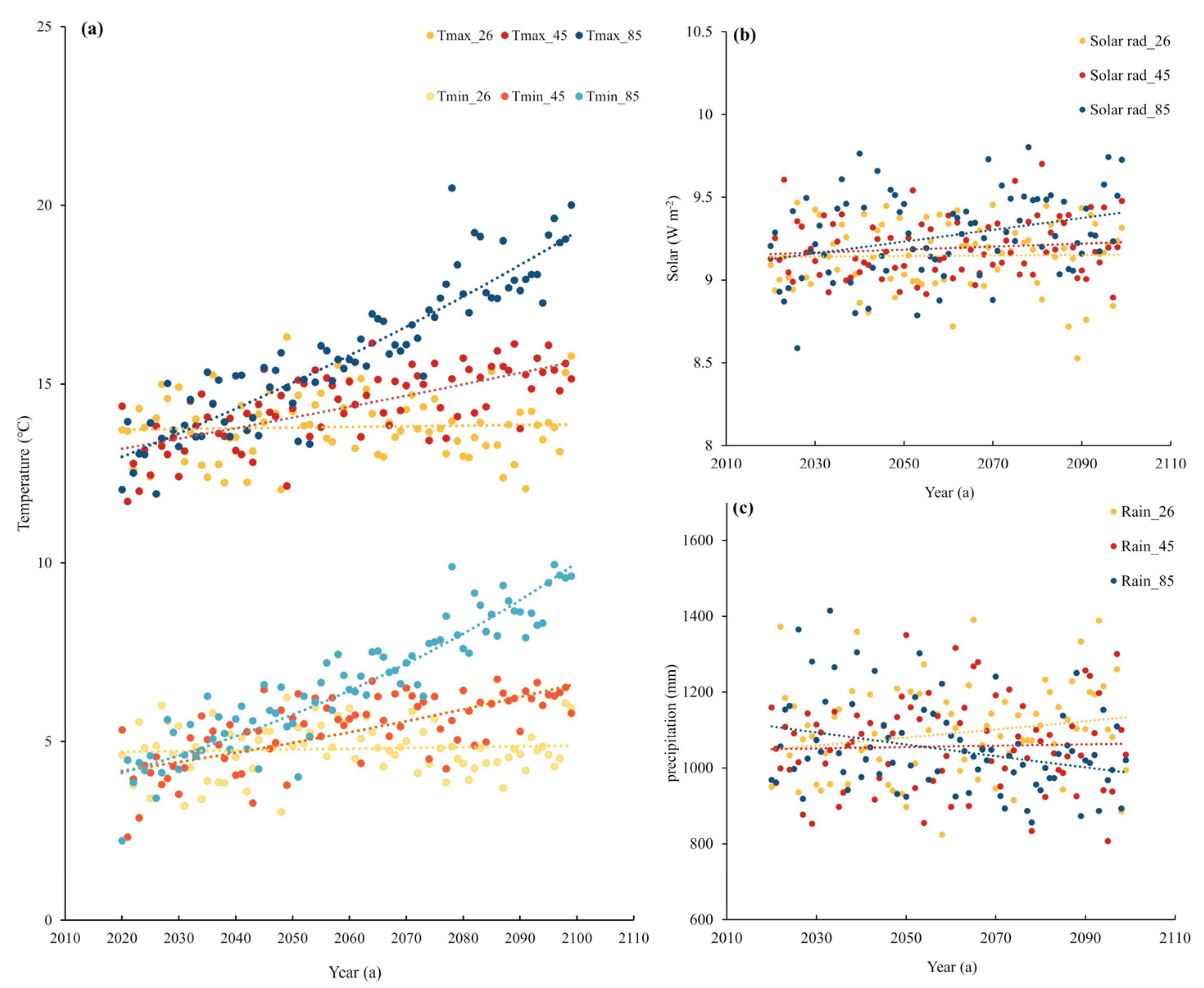
References
- Kramer, P.J. Carbon Dioxide Concentration, Photosynthesis, and Dry Matter Production. BioScience 1981, 31, 29–33. [Google Scholar] [CrossRef]
- Reichstein, M.; Carvalhais, N. Aspects of Forest Biomass in the Earth System: Its Role and Major Unknowns. Surv. Geophys. 2019, 40, 693–707. [Google Scholar] [CrossRef]
- Yadav, V.S.; Yadav, S.S.; Gupta, S.R.; Meena, R.S.; Lal, R.; Sheoran, N.S.; Jhariya, M.K. Carbon Sequestration Potential and CO2 Fluxes in a Tropical Forest Ecosystem. Ecol. Eng. 2022, 176, 106541. [Google Scholar] [CrossRef]
- Hansen, W.D.; Schwartz, N.B.; Williams, A.P.; Albrich, K.; Kueppers, L.M.; Rammig, A.; Reyer, C.P.O.; Staver, A.C.; Seidl, R. Global Forests Are Influenced by the Legacies of Past Inter-Annual Temperature Variability. Environ. Res. Ecol. 2022, 1, 011001. [Google Scholar] [CrossRef]
- Augusto, L.; Boča, A. Tree Functional Traits, Forest Biomass, and Tree Species Diversity Interact with Site Properties to Drive Forest Soil Carbon. Nat. Commun. 2022, 13, 1097. [Google Scholar] [CrossRef] [PubMed]
- Erdozain, M.; Bonet, J.A.; Martínez de Aragón, J.; de-Miguel, S. Forest Thinning and Climate Interactions Driving Early-Stage Regeneration Dynamics of Maritime Pine in Mediterranean Areas. For. Ecol. Manag. 2023, 539, 121036. [Google Scholar] [CrossRef]
- Yu, J.; Zhang, X.; Xu, C.; Hao, M.; Choe, C.; He, H. Thinning Can Increase Shrub Diversity and Decrease Herb Diversity by Regulating Light and Soil Environments. Front. Plant Sci. 2022, 13, 948648. [Google Scholar] [CrossRef]
- Zhang, X.; Guan, D.; Li, W.; Sun, D.; Jin, C.; Yuan, F.; Wang, A.; Wu, J. The Effects of Forest Thinning on Soil Carbon Stocks and Dynamics: A Meta-Analysis. For. Ecol. Manag. 2018, 429, 36–43. [Google Scholar] [CrossRef]
- D’Amato, A.W.; Bradford, J.B.; Fraver, S.; Palik, B.J. Effects of Thinning on Drought Vulnerability and Climate Response in North Temperate Forest Ecosystems. Ecol. Appl. 2013, 23, 1735–1742. [Google Scholar] [CrossRef]
- Gong, C.; Tan, Q.; Liu, G.; Xu, M. Forest Thinning Increases Soil Carbon Stocks in China. For. Ecol. Manag. 2021, 482, 118812. [Google Scholar] [CrossRef]
- Olajuyigbe, S.; Tobin, B.; Saunders, M.; Nieuwenhuis, M. Forest Thinning and Soil Respiration in a Sitka Spruce Forest in Ireland. Agric. For. Meteorol. 2012, 157, 86–95. [Google Scholar] [CrossRef]
- Melikov, C.H.; Bukoski, J.J.; Cook-Patton, S.C.; Ban, H.; Chen, J.L.; Potts, M.D. Quantifying the Effect Size of Management Actions on Aboveground Carbon Stocks in Forest Plantations. Curr. For. Rep. 2023, 9, 131–148. [Google Scholar] [CrossRef] [PubMed]
- Rimal, S.; Djahangard, M.; Yousefpour, R. Forest Management under Climate Change: A Decision Analysis of Thinning Interventions for Water Services and Biomass in a Norway Spruce Stand in South Germany. Land 2022, 11, 446. [Google Scholar] [CrossRef]
- Heimann, M.; Reichstein, M. Terrestrial Ecosystem Carbon Dynamics and Climate Feedbacks. Nature 2008, 451, 289–292. [Google Scholar] [CrossRef] [PubMed]
- Higgins, S.I.; Conradi, T.; Muhoko, E. Shifts in Vegetation Activity of Terrestrial Ecosystems Attributable to Climate Trends. Nat. Geosci. 2023, 16, 147–153. [Google Scholar] [CrossRef]
- Beer, C.; Reichstein, M.; Tomelleri, E.; Ciais, P.; Jung, M.; Carvalhais, N.; Rödenbeck, C.; Arain, M.A.; Baldocchi, D.; Bonan, G.B.; et al. Terrestrial Gross Carbon Dioxide Uptake: Global Distribution and Covariation with Climate. Science 2010, 329, 834–838. [Google Scholar] [CrossRef]
- Medlyn, B.E.; Pepper, D.A.; O’Grady, A.P.; Keith, H. Linking Leaf and Tree Water Use with an Individual-Tree Model. Tree Physiol. 2007, 27, 1687–1699. [Google Scholar] [CrossRef]
- Sturtevant, B.R. Forest Processes from Stands to Landscapes: Exploring Model Forecast Uncertainties Using Cross-Scale Model Comparison. Can. J. For. Res. 2010, 40, 2345–2359. [Google Scholar] [CrossRef]
- Landsberg, J.J.; Waring, R.H. A Generalised Model of Forest Productivity Using Simplified Concepts of Radiation-Use Efficiency, Carbon Balance and Partitioning. For. Ecol. Manag. 1997, 95, 209–228. [Google Scholar] [CrossRef]
- Restrepo, H.I.; Montes, C.R.; Bullock, B.P.; Mei, B. The Effect of Climate Variability Factors on Potential Net Primary Productivity Uncertainty: An Analysis with a Stochastic Spatial 3-PG Model. Agric. For. Meteorol. 2022, 315, 108812. [Google Scholar] [CrossRef]
- Running, S.W.; Coughlan, J.C. A General Model of Forest Ecosystem Processes for Regional Applications I. Hydrologic Balance, Canopy Gas Exchange and Primary Production Processes. Ecol. Model. 1988, 42, 125–154. [Google Scholar] [CrossRef]
- Yan, M.; Mao, F.; Du, H.; Li, X.; Chen, Q.; Ni, C.; Huang, Z.; Xu, Y.; Gong, Y.; Guo, K.; et al. Spatiotemporal Dynamic of Subtropical Forest Carbon Storage and Its Resistance and Resilience to Drought in China. Front. Plant Sci. 2023, 14, 1067552. [Google Scholar] [CrossRef] [PubMed]
- Dang, A.T.N.; Nandy, S.; Srinet, R.; Luong, N.V.; Ghosh, S.; Senthil Kumar, A. Forest Aboveground Biomass Estimation Using Machine Learning Regression Algorithm in Yok Don National Park, Vietnam. Ecol. Inform. 2019, 50, 24–32. [Google Scholar] [CrossRef]
- Huy, B.; Truong, N.Q.; Khiem, N.Q.; Poudel, K.P.; Temesgen, H. Deep Learning Models for Improved Reliability of Tree Aboveground Biomass Prediction in the Tropical Evergreen Broadleaf Forests. For. Ecol. Manag. 2022, 508, 120031. [Google Scholar] [CrossRef]
- Kraft, B.; Jung, M.; Körner, M.; Requena Mesa, C.; Cortés, J.; Reichstein, M. Identifying Dynamic Memory Effects on Vegetation State Using Recurrent Neural Networks. Front. Big Data 2019, 2, 31. [Google Scholar] [CrossRef]
- De Oliveira Neto, R.R.; Leite, H.G.; Gleriani, J.M.; Strimbu, B.M. Estimation of Eucalyptus Productivity Using Efficient Artificial Neural Network. Eur. J. For. Res. 2022, 141, 129–151. [Google Scholar] [CrossRef]
- Xu, Q.; Lei, X.; Zhang, H. A Novel Method for Approaching the Compatibility of Tree Biomass Estimation by Multi-Task Neural Networks. For. Ecol. Manag. 2022, 508, 120011. [Google Scholar] [CrossRef]
- Gu, Y.; Li, B.; Meng, Q. Hybrid Interpretable Predictive Machine Learning Model for Air Pollution Prediction. Neurocomputing 2022, 468, 123–136. [Google Scholar] [CrossRef]
- Narayanan, H.; Cruz Bournazou, M.N.; Guillén Gosálbez, G.; Butté, A. Functional-Hybrid Modeling through Automated Adaptive Symbolic Regression for Interpretable Mathematical Expressions. Chem. Eng. J. 2022, 430, 133032. [Google Scholar] [CrossRef]
- Perry, G.L.W.; Seidl, R.; Bellvé, A.M.; Rammer, W. An Outlook for Deep Learning in Ecosystem Science. Ecosystems 2022, 25, 1700–1718. [Google Scholar] [CrossRef]
- Irrgang, C.; Boers, N.; Sonnewald, M.; Barnes, E.A.; Kadow, C.; Staneva, J.; Saynisch-Wagner, J. Towards Neural Earth System Modelling by Integrating Artificial Intelligence in Earth System Science. Nat. Mach. Intell. 2021, 3, 667–674. [Google Scholar] [CrossRef]
- Reichstein, M.; Camps-Valls, G.; Stevens, B.; Jung, M.; Denzler, J.; Carvalhais, N. Prabhat Deep Learning and Process Understanding for Data-Driven Earth System Science. Nature 2019, 566, 195–204. [Google Scholar] [CrossRef] [PubMed]
- Konapala, G.; Kao, S.-C.; Painter, S.L.; Lu, D. Machine Learning Assisted Hybrid Models Can Improve Streamflow Simulation in Diverse Catchments across the Conterminous US. Environ. Res. Lett. 2020, 15, 104022. [Google Scholar] [CrossRef]
- Xu, T.; Longyang, Q.; Tyson, C.; Zeng, R.; Neilson, B.T. Hybrid Physically Based and Deep Learning Modeling of a Snow Dominated, Mountainous, Karst Watershed. Water Resour. Res. 2022, 58, e2021WR030993. [Google Scholar] [CrossRef]
- Jiang, S.; Zheng, Y.; Solomatine, D. Improving AI System Awareness of Geoscience Knowledge: Symbiotic Integration of Physical Approaches and Deep Learning. Geophys. Res. Lett. 2020, 47, e2020GL088229. [Google Scholar] [CrossRef]
- Li, M.; Yang, Y.; He, Z.; Guo, X.; Zhang, R.; Huang, B. A Wind Speed Forecasting Model Based on Multi-Objective Algorithm and Interpretability Learning. Energy 2023, 269, 126778. [Google Scholar] [CrossRef]
- Wang, T.; Lin, Q. Hybrid Predictive Models: When an Interpretable Model Collaborates with a Black-Box Model. J. Mach. Learn. Res. 2021, 22, 6085–6122. [Google Scholar]
- Pradhan, K.; Ettinger, A.K.; Case, M.J.; Hille Ris Lambers, J. Applying Climate Change Refugia to Forest Management and Old-Growth Restoration. Glob. Chang. Biol. 2023, 29, 3692–3706. [Google Scholar] [CrossRef]
- Reyer, C.P.; Silveyra Gonzalez, R.; Dolos, K.; Hartig, F.; Hauf, Y.; Noack, M.; Lasch-Born, P.; Rötzer, T.; Pretzsch, H.; Meesenburg, H.; et al. The PROFOUND Database for Evaluating Vegetation Models and Simulating Climate Impacts on European Forests. Earth Syst. Sci. Data 2020, 12, 1295–1320. [Google Scholar] [CrossRef]
- Sands, P.J.; Landsberg, J.J. Parameterisation of 3-PG for Plantation Grown Eucalyptus Globulus. For. Ecol. Manag. 2002, 163, 273–292. [Google Scholar] [CrossRef]
- Song, X.; Song, Y. Introducing 3-PG2Py, an Open-Source Forest Growth Model in Python. Environ. Model. Softw. 2022, 150, 105358. [Google Scholar] [CrossRef]
- Wallach, D.; Makowski, D.; Jones, J.W.; Brun, F. Chapter 3—The R Programming Language and Software. In Working with Dynamic Crop Models, 2nd ed.; Wallach, D., Makowski, D., Jones, J.W., Brun, F., Eds.; Academic Press: San Diego, CA, USA, 2014; pp. 71–117. ISBN 978-0-12-397008-4. [Google Scholar]
- Trotsiuk, V.; Hartig, F.; Forrester, D.I. R3PG—An r Package for Simulating Forest Growth Using the 3-PG Process-Based Model. Methods Ecol. Evol. 2020, 11, 1470–1475. [Google Scholar] [CrossRef]
- Morris, M.D. Factorial Sampling Plans for Preliminary Computational Experiments. Technometrics 1991, 33, 161–174. [Google Scholar] [CrossRef]
- Caruana, R. Multitask Learning. Mach. Learn. 1997, 28, 41–75. [Google Scholar] [CrossRef]
- Wang, Y.; Zhang, D.; Wulamu, A. A Multitask Learning Model with Multiperspective Attention and Its Application in Recommendation. Comput. Intell. Neurosci. 2021, 2021, 8550270. [Google Scholar] [CrossRef] [PubMed]
- Qi, Y.; Li, Q.; Karimian, H.; Liu, D. A Hybrid Model for Spatiotemporal Forecasting of PM2.5 Based on Graph Convolutional Neural Network and Long Short-Term Memory. Sci. Total Environ. 2019, 664, 1–10. [Google Scholar] [CrossRef]
- Wang, S.; Ren, Y.; Xia, B.; Liu, K.; Li, H. Prediction of Atmospheric Pollutants in Urban Environment Based on Coupled Deep Learning Model and Sensitivity Analysis. Chemosphere 2023, 331, 138830. [Google Scholar] [CrossRef]
- Seltzer, M.L.; Droppo, J. Multi-Task Learning in Deep Neural Networks for Improved Phoneme Recognition. In Proceedings of the 2013 IEEE International Conference on Acoustics, Speech and Signal Processing, Vancouver, BC, Canada, 26–31 May 2013; pp. 6965–6969. [Google Scholar]
- Zhang, Y.; Yang, Q. An Overview of Multi-Task Learning. Natl. Sci. Rev. 2018, 5, 30–43. [Google Scholar] [CrossRef]
- Carvalho, D.; Rafael, S.; Monteiro, A.; Rodrigues, V.; Lopes, M.; Rocha, A. How Well Have CMIP3, CMIP5 and CMIP6 Future Climate Projections Portrayed the Recently Observed Warming. Sci. Rep. 2022, 12, 11983. [Google Scholar] [CrossRef]
- Wang, Y.; Wei, X.; del Campo, A.D.; Winkler, R.; Wu, J.; Li, Q.; Liu, W. Juvenile Thinning Can Effectively Mitigate the Effects of Drought on Tree Growth and Water Consumption in a Young Pinus Contorta Stand in the Interior of British Columbia, Canada. For. Ecol. Manag. 2019, 454, 117667. [Google Scholar] [CrossRef]
- Zhou, F.; Chai, F.; Huang, D.; Xue, H.; Chen, J.; Xiu, P.; Xuan, J.; Li, J.; Zeng, D.; Ni, X.; et al. Investigation of Hypoxia off the Changjiang Estuary Using a Coupled Model of ROMS-CoSiNE. Prog. Oceanogr. 2017, 159, 237–254. [Google Scholar] [CrossRef]
- Willard, J.; Jia, X.; Xu, S.; Steinbach, M.; Kumar, V. Integrating Scientific Knowledge with Machine Learning for Engineering and Environmental Systems. ACM Comput. Surv. 2022, 55, 66. [Google Scholar] [CrossRef]
- Zhang, Q.; Wang, R.; Qi, Y.; Wen, F. A Watershed Water Quality Prediction Model Based on Attention Mechanism and Bi-LSTM. Environ. Sci. Pollut. Res. 2022, 29, 75664–75680. [Google Scholar] [CrossRef]
- Geng, Y.; Yue, Q.; Zhang, C.; Zhao, X.; von Gadow, K. Dynamics and Drivers of Aboveground Biomass Accumulation during Recovery from Selective Harvesting in an Uneven-Aged Forest. Eur. J. For. Res. 2021, 140, 1163–1178. [Google Scholar] [CrossRef]
- Zhou, H.; Meng, S.; Liu, Q. Long-Term Response of Living Forest Biomass to Extensive Logging in Subtropical China. J. For. Res. 2019, 30, 1679–1687. [Google Scholar] [CrossRef]
- Deng, C.; Ma, F.; Xu, X.; Zhu, B.; Tao, J.; Li, Q. Allocation Patterns and Temporal Dynamics of Chinese Fir Biomass in Hunan Province, China. Forests 2023, 14, 286. [Google Scholar] [CrossRef]
- Chen, R.; Ran, J.; Hu, W.; Dong, L.; Ji, M.; Jia, X.; Lu, J.; Gong, H.; Aqeel, M.; Yao, S.; et al. Effects of Biotic and Abiotic Factors on Forest Biomass Fractions. Natl. Sci. Rev. 2021, 8, nwab025. [Google Scholar] [CrossRef]
- Zhang, W.-P.; Jia, X.; Morris, E.C.; Bai, Y.-Y.; Wang, G.-X. Stem, Branch and Leaf Biomass-Density Relationships in Forest Communities. Ecol. Res. 2012, 27, 819–825. [Google Scholar] [CrossRef]
- Wang, Z.C.; Li, Y.X.; Meng, Y.B.; Wang, C. Effect of Tending and Thinning on Spatial and Carbon Distribution Patterns of Natural Mixed Broadlesf-Conifer Secondary Forest in Xiaoxing’an Mountains, Pr China. Appl. Ecol. Environ. Res. 2021, 19, 4751–4764. [Google Scholar] [CrossRef]
- Subedi, S.; Kane, M.; Zhao, D.; Borders, B.; Greene, D. Cultural Intensity and Planting Density Effects on Aboveground Biomass of 12-Year-Old Loblolly Pine Trees in the Upper Coastal Plain and Piedmont of the Southeastern United States. For. Ecol. Manag. 2012, 267, 157–162. [Google Scholar] [CrossRef]
- Graves, A. Long Short-Term Memory. In Supervised Sequence Labelling with Recurrent Neural Networks; Graves, A., Ed.; Studies in Computational Intelligence; Springer: Berlin/Heidelberg, Germany, 2012; pp. 37–45. ISBN 978-3-642-24797-2. [Google Scholar]
- Li, C.; Liu, Y.; Zhu, T.; Zhou, M.; Dou, T.; Liu, L.; Wu, X. Considering Time-Lag Effects Can Improve the Accuracy of NPP Simulation Using a Light Use Efficiency Model. J. Geogr. Sci. 2023, 33, 961–979. [Google Scholar] [CrossRef]
- Wu, D.; Zhao, X.; Liang, S.; Zhou, T.; Huang, K.; Tang, B.; Zhao, W. Time-Lag Effects of Global Vegetation Responses to Climate Change. Glob. Change Biol. 2015, 21, 3520–3531. [Google Scholar] [CrossRef] [PubMed]
- Cao, M.; Liang, Y.; Zhu, Y.; Lü, G.; Ma, Z. Prediction for Origin-Destination Distribution of Dockless Shared Bicycles: A Case Study in Nanjing City. Front. Public Health 2022, 10, 849766. [Google Scholar] [CrossRef] [PubMed]
- Greff, K.; Srivastava, R.K.; Koutnik, J.; Steunebrink, B.R.; Schmidhuber, J. LSTM: A Search Space Odyssey. IEEE Trans. Neural. Netw. Learn. Syst. 2017, 28, 2222–2232. [Google Scholar] [CrossRef] [PubMed]
- Leuchner, M.; Hertel, C.; Rötzer, T.; Seifert, T.; Weigt, R.; Werner, H.; Menzel, A. Solar Radiation as a Driver for Growth and Competition in Forest Stands. In Growth and Defence in Plants: Resource Allocation at Multiple Scales; Matyssek, R., Schnyder, H., Oßwald, W., Ernst, D., Munch, J.C., Pretzsch, H., Eds.; Ecology Research; Springer: Berlin/Heidelberg, Germany, 2012; pp. 175–191. ISBN 978-3-642-30645-7. [Google Scholar]
- Reitz, O.; Bogena, H.; Neuwirth, B.; Sanchez-Azofeifa, A.; Graf, A.; Bates, J.; Leuchner, M. Environmental Drivers of Gross Primary Productivity and Light Use Efficiency of a Temperate Spruce Forest. J. Geophys. Res. Biogeosci. 2023, 128, e2022JG007197. [Google Scholar] [CrossRef]
- Zhao, J.; Lange, H.; Meissner, H. Estimating Carbon Sink Strength of Norway Spruce Forests Using Machine Learning. Forests 2022, 13, 1721. [Google Scholar] [CrossRef]
- Honkaniemi, J.; Rammer, W.; Seidl, R. Norway Spruce at the Trailing Edge: The Effect of Landscape Configuration and Composition on Climate Resilience. Landsc. Ecol. 2020, 35, 591–606. [Google Scholar] [CrossRef]
- Aiba, S.; Kitayama, K. Light and Nutrient Limitations for Tree Growth on Young versus Old Soils in a Bornean Tropical Montane Forest. J. Plant. Res. 2020, 133, 665–679. [Google Scholar] [CrossRef]
- Simon, D.-C.; Ameztegui, A. Modelling the Influence of Thinning Intensity and Frequency on the Future Provision of Ecosystem Services in Mediterranean Mountain Pine Forests. Eur. J. For. Res. 2023, 142, 521–535. [Google Scholar] [CrossRef]
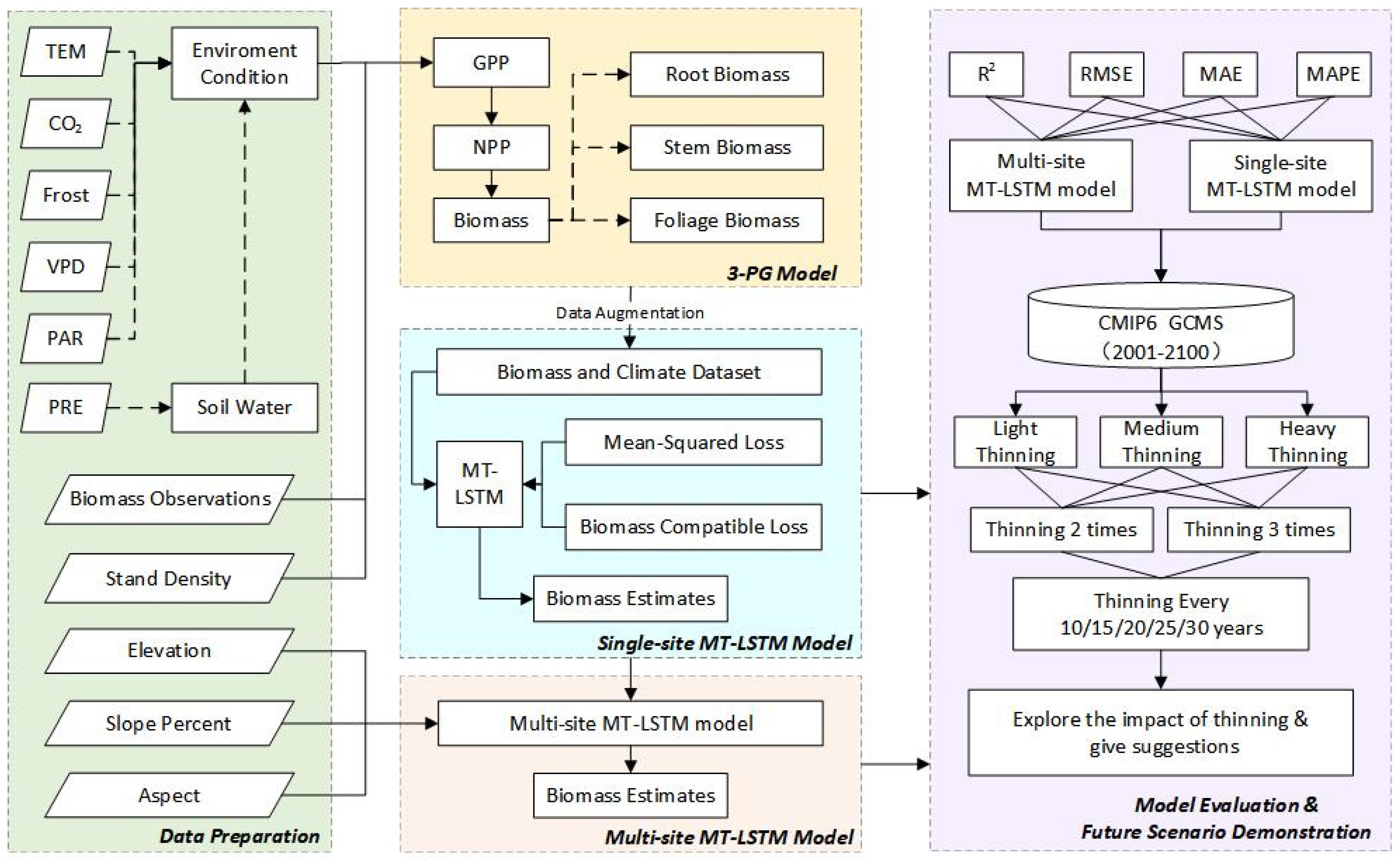
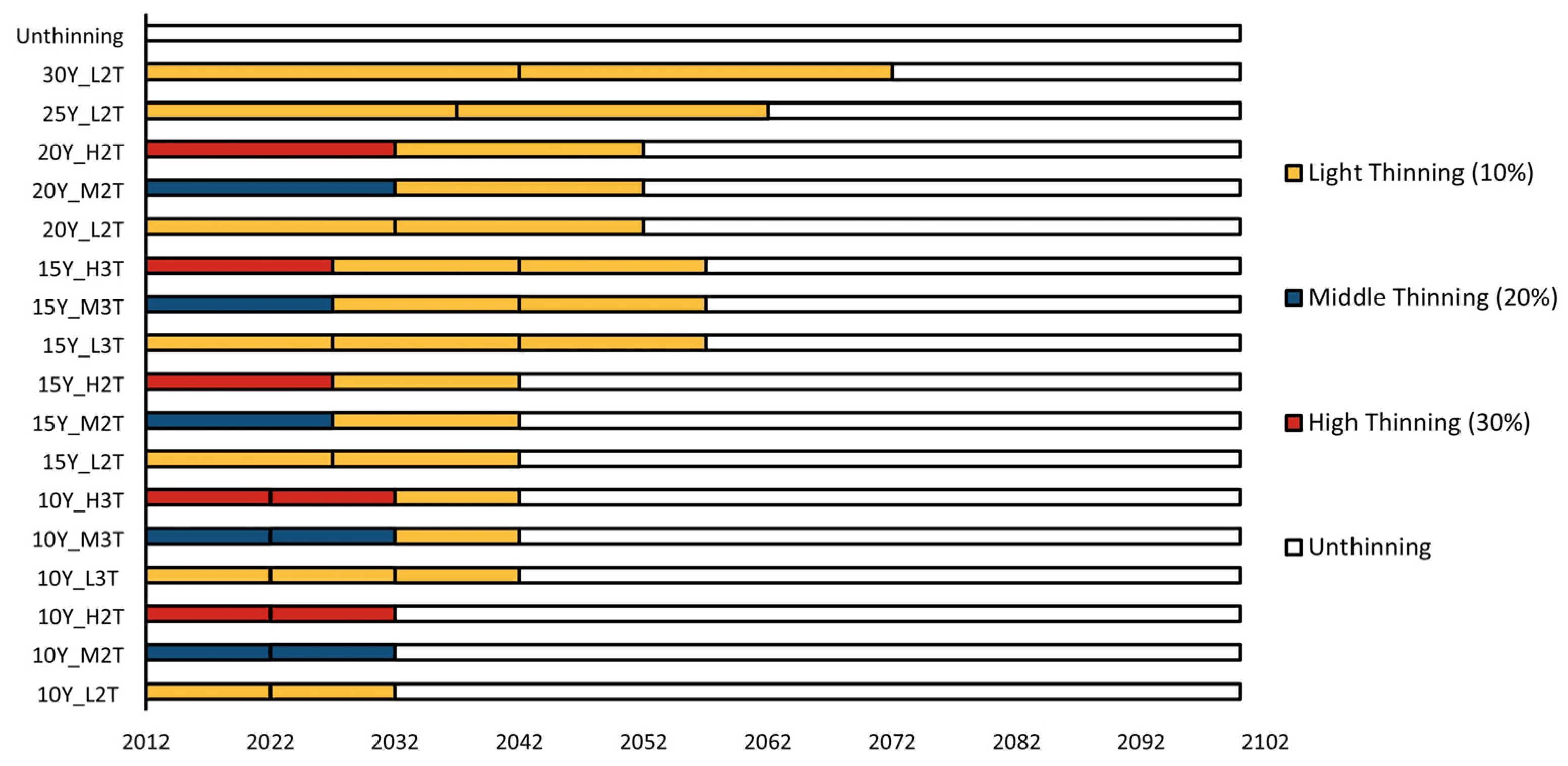
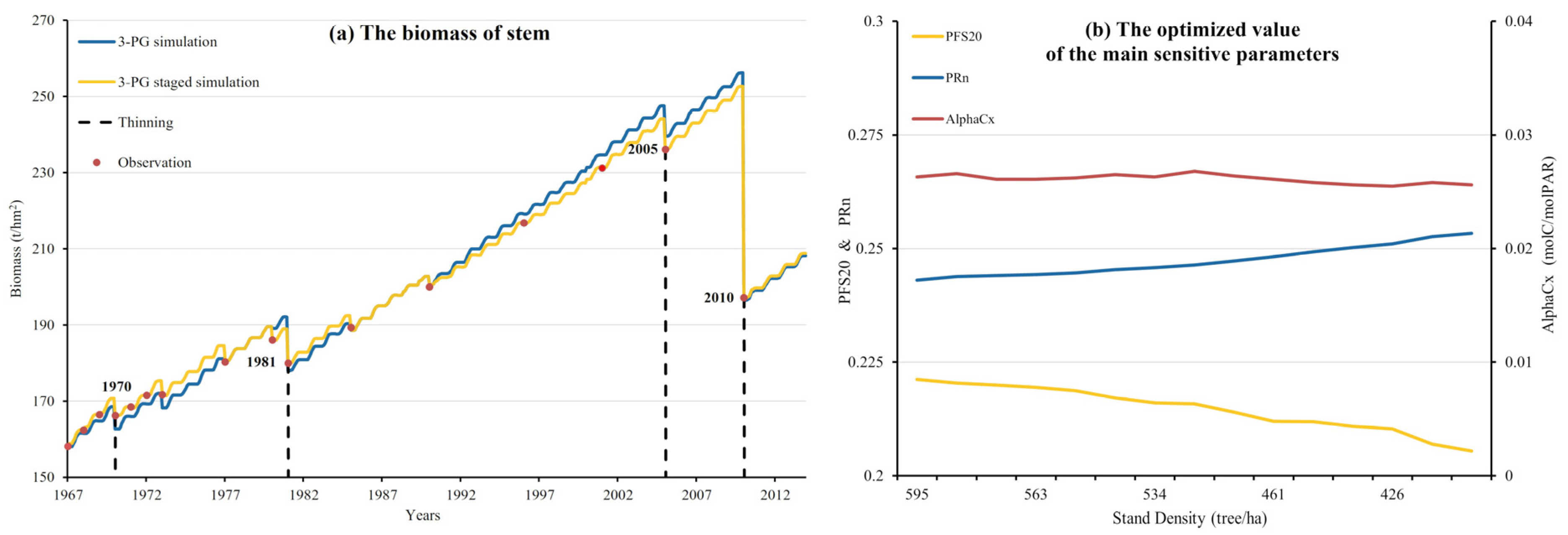

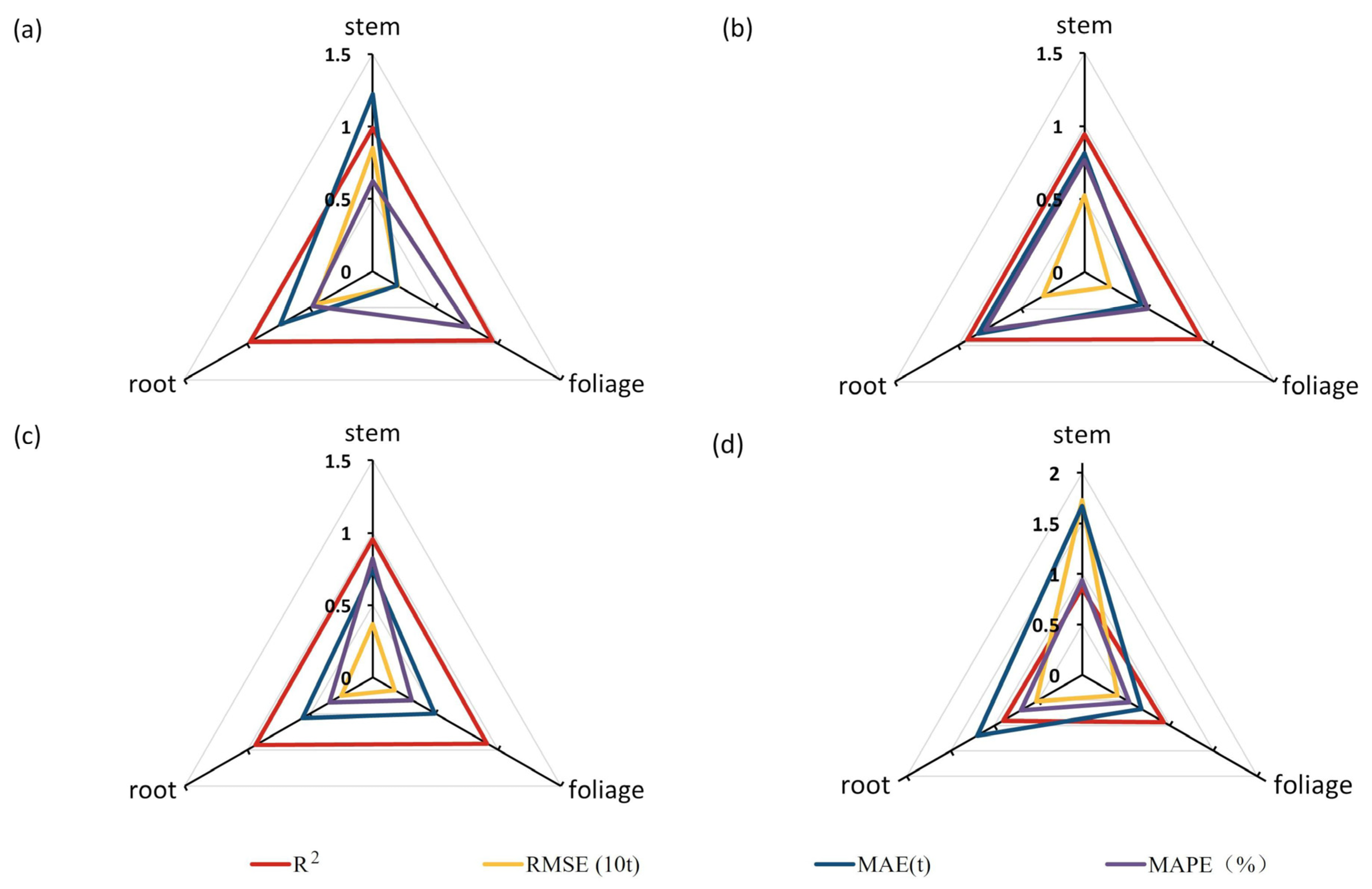
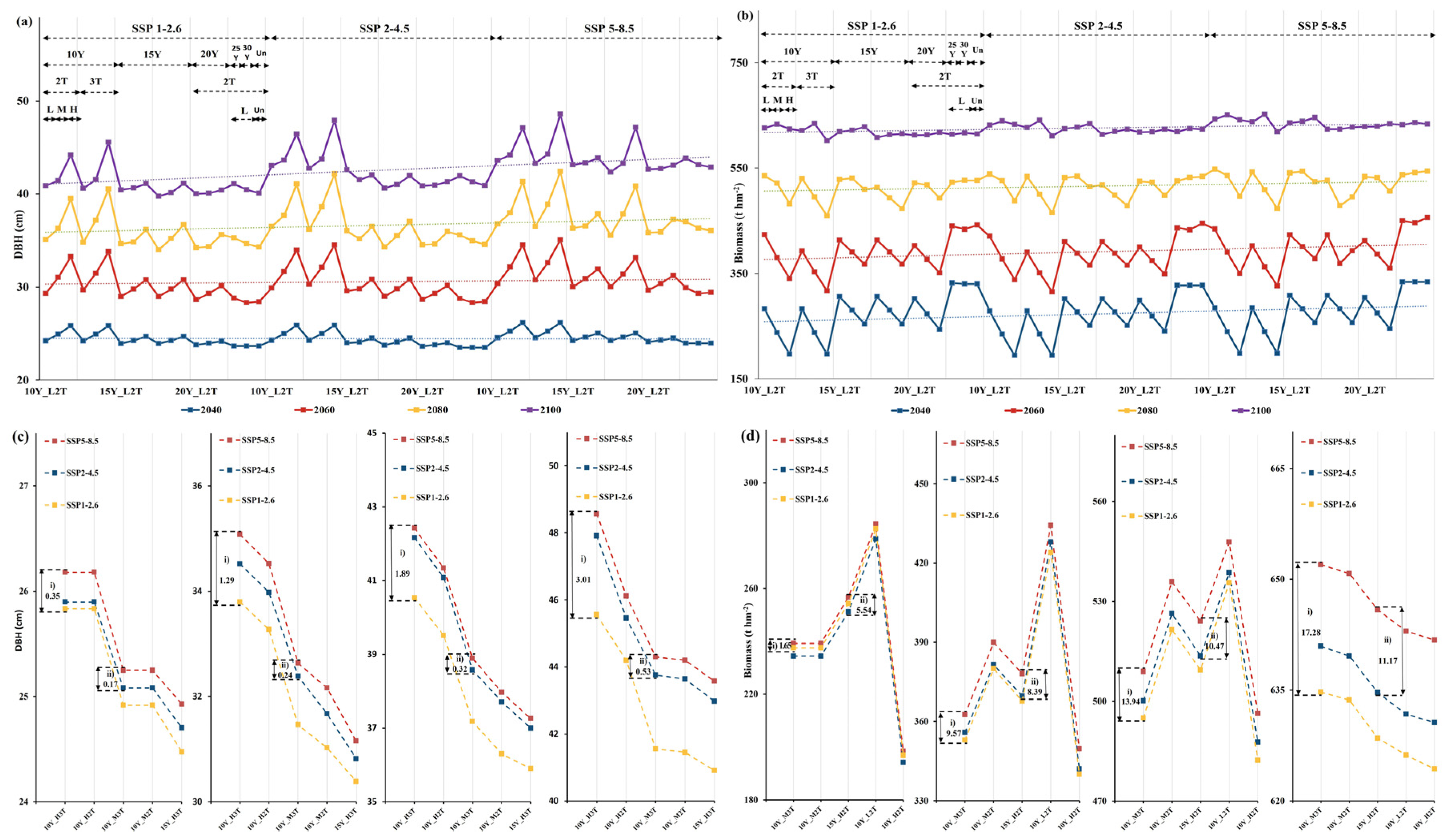
| Site | Longitude and Latitude | Elevation (m) | a Forest Age Range (Years) | b Forest Biomass Range (t/hm2) | c Number of Thinning |
|---|---|---|---|---|---|
| Bily Kriz | 18°19′ E, 49°18′ N | 875 | 16–34 | 34.49~147.67 | 3 |
| Hyytiala | 24°17′ E, 61°50′ N | 185 | 34–50 | 128.86~201.78 | 1 |
| Solling | 9°34′ E, 51°45′ N | 508 | 85–133 | 250.67~372.96 | 4 |
Disclaimer/Publisher’s Note: The statements, opinions and data contained in all publications are solely those of the individual author(s) and contributor(s) and not of MDPI and/or the editor(s). MDPI and/or the editor(s) disclaim responsibility for any injury to people or property resulting from any ideas, methods, instructions or products referred to in the content. |
© 2023 by the authors. Licensee MDPI, Basel, Switzerland. This article is an open access article distributed under the terms and conditions of the Creative Commons Attribution (CC BY) license (https://creativecommons.org/licenses/by/4.0/).
Share and Cite
Qin, J.; Ma, M.; Zhu, Y.; Wu, B.; Su, X. 3PG-MT-LSTM: A Hybrid Model under Biomass Compatibility Constraints for the Prediction of Long-Term Forest Growth to Support Sustainable Management. Forests 2023, 14, 1482. https://doi.org/10.3390/f14071482
Qin J, Ma M, Zhu Y, Wu B, Su X. 3PG-MT-LSTM: A Hybrid Model under Biomass Compatibility Constraints for the Prediction of Long-Term Forest Growth to Support Sustainable Management. Forests. 2023; 14(7):1482. https://doi.org/10.3390/f14071482
Chicago/Turabian StyleQin, Jushuang, Menglu Ma, Yutong Zhu, Baoguo Wu, and Xiaohui Su. 2023. "3PG-MT-LSTM: A Hybrid Model under Biomass Compatibility Constraints for the Prediction of Long-Term Forest Growth to Support Sustainable Management" Forests 14, no. 7: 1482. https://doi.org/10.3390/f14071482
APA StyleQin, J., Ma, M., Zhu, Y., Wu, B., & Su, X. (2023). 3PG-MT-LSTM: A Hybrid Model under Biomass Compatibility Constraints for the Prediction of Long-Term Forest Growth to Support Sustainable Management. Forests, 14(7), 1482. https://doi.org/10.3390/f14071482








